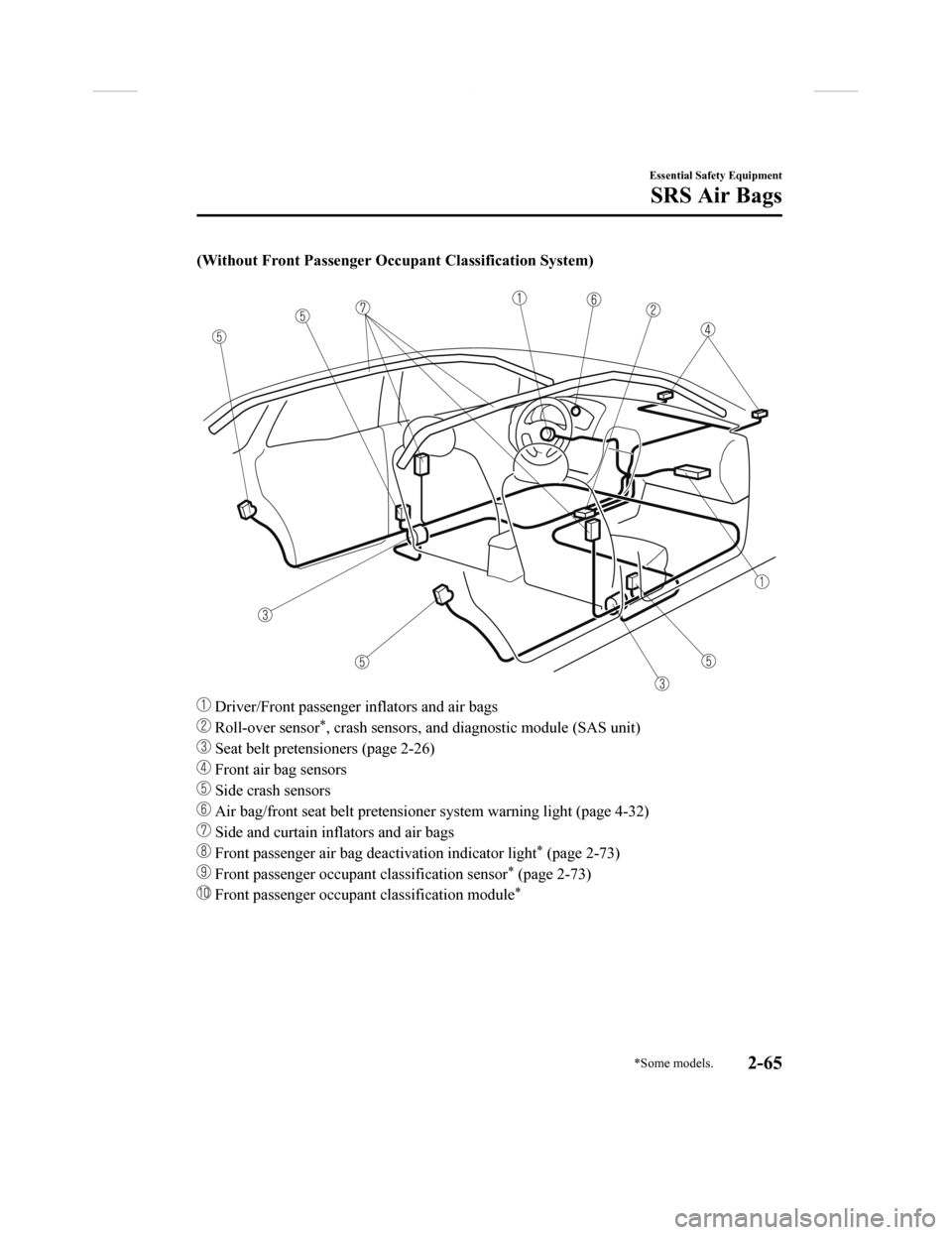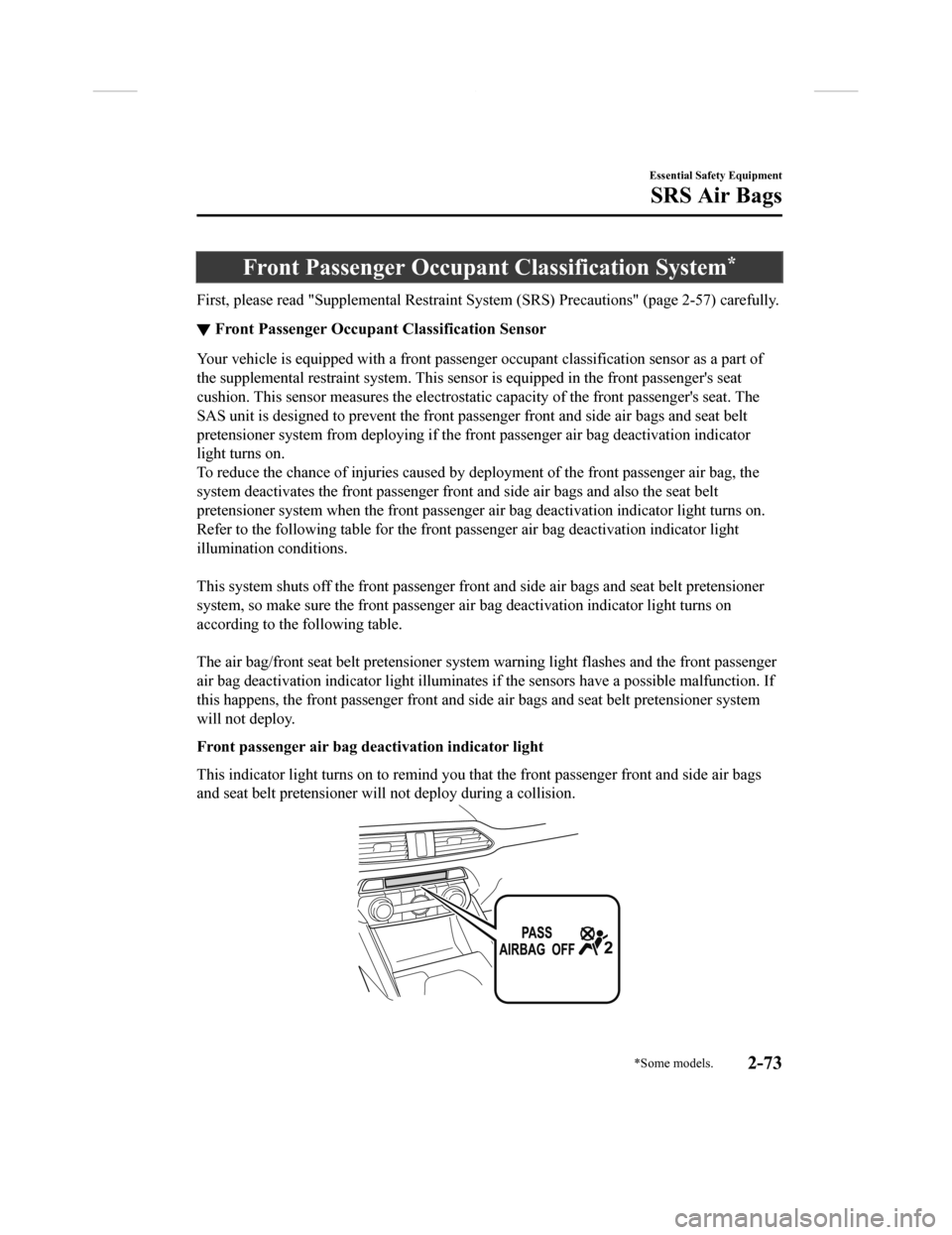sensor MAZDA MODEL CX-9 2018 (in English) User Guide
[x] Cancel search | Manufacturer: MAZDA, Model Year: 2018, Model line: MODEL CX-9, Model: MAZDA MODEL CX-9 2018Pages: 640
Page 77 of 640

(Without Front Passenger Occupant Classification System)
Driver/Front passenger inflators and air bags
Roll-over sensor*, crash sensors, and diagnostic module (SAS unit)
Seat belt pretensioners (page 2-26)
Front air bag sensors
Side crash sensors
Air bag/front seat belt pretensioner system warning light (page 4-32)
Side and curtain inflators and air bags
Front passenger air bag deactivation indicator light* (page 2-73)
Front passenger occupant classification sensor* (page 2-73)
Front passenger occupant classification module*
Essential Safety Equipment
SRS Air Bags
*Some models.2-65
CX-9_8GC3-EA-17G_Edition1 2017-5-29 10:13:38
Page 78 of 640

How the SRS Air Bags Work
Your Mazda is equipped with the following types of SRS air bags. SRS air bags are
designed to work together with the seat belts to help to reduce injuries during an accident.
The SRS air bags are designed to provide further protection for passengers in addition to the
seat belt functions. Be sure to wear seat belts properly.
â–¼ Front Seat Bel
t Pretensioners
The front seat belt pretensioners are designed to deploy in mod erate or severe frontal, near
frontal collisions.
In addition, the pretensioners o perate when a side collision (only on the side in which the
collision occurs) or a roll-over accident is detected. The pretensioners operate differently
depending on what types of air bags are equipped. For more deta ils about seat belt
pretensioner operation, refer to the SRS Air Bag Deployment Cri teria (page 2-70).
â–¼Driver Air Bag
The driver's air bag is mounted in the steering wheel.
When air bag crash sensors detect a frontal impact of greater than moderate force, the
driver's air bag inflates quickly helping to reduce injury main
ly to the driver's head or chest
caused by directly hitting the steering wheel.
For more details about air bag de ployment, refer to "SRS Air Bag Deployment Criteria"
(page 2-70).
(With Front Passenger Occupa nt Classification System)
The driver's dual-stage air bag controls air bag inflation in t wo energy stages. During an
impact of moderate severity, the driver's air bag deploys with lesser energy, whereas during
more severe impacts, it deploys with more energy.
Essential Safety Equipment
SRS Air Bags
2-66
CX-9_8GC3-EA-17G_Edition1 2017-5-29 10:13:38
Page 79 of 640

â–¼Front Passenger Air Bag
The front passenger air bag is mounted in the front passenger dashboard.
The inflation mechanism for the fr
ont passenger air bag is the same as the driver's air bag.
For more details about air bag deployment, refer to "SRS Air Ba g Deployment Criteria"
(page 2-70).
(With Front Passenger Occupa nt Classification System)
In addition, the front passenger air bag is designed to only de ploy when the front passenger
occupant classification sensor detects a passenger sitting on t he front passenger's seat. For
details, refer to the front passenger occupant classification s ystem (page 2-73).
â–¼Side Air Bags
The side air bags are mounted in the outboard sides of the fron
t seatbacks.
When the air bag crash sensors detect a s ide impact of greater than moderate force, the
system inflates the side air bag only on the side in which the vehicle was hit. The side air
bag inflates quickly to reduce i njury to the driver or front passenger's chest caused by
directly hitting interior parts such as a door or window.
For more details about air bag deployment, refer to "SRS Air Ba g Deployment Criteria"
(page 2-70).
Essential Safety Equipment
SRS Air Bags
2-67
CX-9_8GC3-EA-17G_Edition1 2017-5-29 10:13:38
Page 80 of 640

(With Front Passenger Occupant Classification System)
In addition, the front passenger side bag is designed to only d eploy when the front passenger
occupant classification sensor detects a passenger sitting on t he front passenger's seat. For
details, refer to the front passenger occupant classification s ystem (page 2-73).
â–¼ Curtain Air Bags
The curtain air bags are mounted in the front and rear window p
illars, and the roof edge
along both sides.
When the air bag crash sensors detect a side impact of greater than moderate force, the
curtain air bag inflates quickly and helps to reduce injury mai nly to the rear outboard
passenger's head caused by dir ectly hitting interior parts such as a door or window.
For more details about air bag de ployment, refer to "SRS Air Bag Deployment Criteria"
(page 2-70).
In a side impact:
Greater than moderate impact to o ne side of the vehicle will cause the curtain air bag on that
side only to inflate.
Only one side curtain air bag will deploy on the
side of the vehicle that receives the force of an
impact.
Essential Safety Equipment
SRS Air Bags
2-68
CX-9_8GC3-EA-17G_Edition1 2017-5-29 10:13:38
Page 82 of 640

SRS Air Bag Deployment Criteria
This chart indicates the applicable SRS equipment that will deploy depending on the type of
collision.
(The illustrations are the representative cases of collisions.)
SRS equip- ment Types of collision
A severe frontal/near frontal colli- sion A severe side colli-
sion
*2A roll-over/nearroll-over*3A rear collision
Front seat
belt preten- sioner X*1 (both sides)
X*1 (impact side
only) X*1 (both sides)
No air bag and
front seat belt pre-
tensioner will be
activated in a rear
collision.
Driver air
bag X
Front pas- senger air bag X
*1
Side air bag
X*1 (impact side
only)
Curtain air bag X (impact side on-
ly) X (both sides)
X: The SRS air bag equipment is
designed to deploy in a collision.*1(With Front Passenger Occupant Classification System)
The front passenger front and side air bags and the seat belt pretensioner are designed to deploy when the front
passenger occupant cla ssification sensor detects a passenger si tting on the front passenger's seat.
*2 In a side collision, the seat belt pretensioners and the side/curtain air bags deploy (only on the side in which the
collision occurs).
*3 (With Front Passenger Occupant Classification System)
In a roll-over accident, the s eat belt pretensioners and the cu rtain air bags deploy.
NOTE
In a frontal offset collision, the equipp ed air bags and pretensioners may all deploy
depending on the direction, angle, and rate of impact.
Essential Safety Equipment
SRS Air Bags
2-70
CX-9_8GC3-EA-17G_Edition1 2017-5-29 10:13:38
Page 85 of 640

Front Passenger Occupant Classification System*
First, please read "Supplemental Restraint System (SRS) Precautions" (page 2-57) carefully.
â–¼Front Passenger Occupant Classification Sensor
Your vehicle is equipped with a front passenger occupant classi
fication sensor as a part of
the supplemental restraint system. This sensor is equipped in t he front passenger's seat
cushion. This sensor measures th e electrostatic capacity of the front passenger's seat. The
SAS unit is designed to prevent the front passenger front and s ide air bags and seat belt
pretensioner system from deployi ng if the front passenger air bag deactivation indicator
light turns on.
To reduce the chance of injuries caused by deployment of the front passenger air bag, the
system deactivates the front passenger front and side air bags and also the seat belt
pretensioner system when the front passenger air bag deactivati on indicator light turns on.
Refer to the following table for the front passenger air bag deactivation indicator light
illumination conditions.
This system shuts off the front passenger front and side air ba gs and seat belt pretensioner
system, so make sure the front passenger air bag deactivation indicator light turns on
according to the following table.
The air bag/front seat belt pretensioner system warning light f lashes and the front passenger
air bag deactivation indicator light illuminates if the sensors have a possible malfunction. If
this happens, the front passenger front and side air bags and s eat belt pretensioner system
will not deploy.
Front passenger air bag deactivation indicator light
This indicator light turns on to r emind you that the front passenger front and side air bags
and seat belt pretensioner will not deploy during a collision.
Essential Safety Equipment
SRS Air Bags
*Some models.2-73
CX-9_8GC3-EA-17G_Edition1 2017-5-29 10:13:38
Page 86 of 640

If the front passenger occupant classification sensor is normal, the indicator light turns on
when the ignition is switched ON. The light turns off after a few seconds. Then, the
indicator light turns on or is off under the following conditio ns:
Front passenger air bag deactiva tion indicator light on/off condition chart
Condition detected by the front
passenger occupant classifica- tion system Front passenger air
bag deactivation indi- cator light Front passenger front
and side air bags Front passenger seat
belt pretensioner sys- tem
Empty (Not occupied) OnDeactivated Deactivated
A child less than 1 year old is
seated in a child-restraint system On
Deactivated Deactivated
Child
*1On or off Deactivated or ready Deactivated or ready
Adult
*2Off Ready Ready
*1 The occupant classification sens or may not detect a child seated on the seat, in a child-restraint system, or a
junior seat depending on the ch ild's physical size and seated posture.
*2 If a smaller adult sits on the front passenger seat, the sensors might detect the person as being a child
depending on the person's physique.
The curtain air bag is ready for inflating regardless of what the front passenger air bag
deactivation indicator light on/off condition chart indicates.
If the front passenger air bag deactivation indicator light doe s not turn on when the ignition
is switched ON and does not turn on as indicated in the front p assenger air bag deactivation
indicator light on/off condition chart, do not allow an occupan t to sit in the front passenger
seat and consult an Authorized M azda Dealer as soon as possible. The system may not work
properly in an accident.
WA R N I N G
Do not allow an occupant in the front passenger's seat to sit with a posture which makes it
difficult for the front passenger occupant classification sensor to detect the occupant
correctly:
Sitting in the front passenger's seat with a posture which makes it difficult for the front
passenger occupant classification sensor to dete ct the occupant correctly is dangerous. If the
front passenger occupant classification sensor ca nnot detect the occupant sitting on the front
passenger's seat correctly, the front passenge r front and side air bags and pretensioner
system may not operate (non-deploy) or they may operate (deploy) accidentally. The front
passenger will not have the su pplementary protection of the air bags or the accidental
operation (deployment) of the air bags could result in serious injury or death.
Under the following conditions, the front passe nger occupant classification sensor cannot
detect a passenger sitting on the front passe nger's seat correctly and the deployment/
non-deployment of the air bags cannot be contro lled as indicated in the front passenger air
bag deactivation indicator light on /off condition chart. For example:
Essential Safety Equipment
SRS Air Bags
2-74
CX-9_8GC3-EA-17G_Edition1 2017-5-29 10:13:38
Page 88 of 640

The front passenger front and side air bags and seat belt pretensioner systems will deactivate
if the front passenger air bag deactivation indicator light turns on.
CAUTION
 To assure proper deployment of the front air bag and to prevent damage to the sensor in
the front seat cushion:
 Do not place sharp objects on the front seat cushion or leave heavy luggage on them.
 Do not spill any liquids on the front seats or under the front seats.
 To allow the sensors to function properly, always perform the following:
 Adjust the front seats as far back as possibl e and always sit upright against the seatbacks
with seat belts worn properly.
 If you place your child on the front passenger seat, secure the child-restraint system
properly and slide the front passenger seat as far back as possible (page 2-44).
NOTE
•The system requires about 10 seconds to alte rnate between turning the front passenger
front and side air bags and seat belt pretensioner system on or off.
•The front passenger air bag deactivation indicato r light may turn on repeatedly if luggage
or other items are put on the front passenger seat, or if the temperature of the vehicle's
interior changes suddenly.
•The front passenger air bag deactivation indicato r light may turn on for 10 seconds if the
electrostatic capacity on the front passenger seat changes.
•The air bag/front seat belt pretensioner system warning light might turn on if the front
passenger seat receives a severe impact.
•If the front passenger air bag deactivation indicator light does not turn on after installing
a child-restraint system on the front passenger seat, first, re-install your child-restraint
system according to the procedure in this owner's manual. Then, if the front passenger air
bag deactivation indicator light still does not tu rn on, install the child-restraint system on
the rear seat and consult an Authorized Mazda Dealer as soon as possible.
•If the front passenger air bag deactivation i ndicator light turns on when an occupant is
seated directly in the front passenger seat, have the passenger re-adjust their posture by
sitting with their feet on the floor, and th en re-fastening the seat belt. If the front
passenger air bag deactivation i ndicator light remains turned on, move the passenger to
the rear seat. If sitting in the rear seat is no t possible, slide the front passenger seat as far
back as possible. Consult an Authorized Mazda Dealer as soon as possible.
Essential Safety Equipment
SRS Air Bags
2-76
CX-9_8GC3-EA-17G_Edition1 2017-5-29 10:13:38
Page 89 of 640

Constant Monitoring
The following components of the air bag systems are monitored by a diagnostic system:
•Front air bag sensors
•Crash sensors, and diagnostic module (SAS unit)
•Side crash sensors
•Air bag modules
•Front seat belt pretensioners
•Air bag/Front seat belt pretensioner system warning light
•Related wiring
(With Front Passenger Occupa nt Classification System)
•Front passenger occupant classification sensor
•Front passenger occupant classification module
•Front passenger air bag deactivation indicator light
The diagnostic module continuously monitors the system's readin ess. This begins when the
ignition is switched ON and contin ues while the vehicle is being driven.
Essential Safety Equipment
SRS Air Bags
2-77
CX-9_8GC3-EA-17G_Edition1 2017-5-29 10:13:38
Page 118 of 640

CAUTION
Sensors are installed on both ends of the
power liftgate. Be careful not to allow the
sensors to be scratched or damaged by
sharp objects, otherwise the liftgate may
no longer open/close automatically. In
addition, if the sensor is damaged while the
liftgate is closing automatically, the system
will stop.
Sensor
NOTE
The jam-safe equipment does not activate
during easy closure operation when the
power liftgate is between the near-shut
position and fully closed position.
When the power liftgate is moving in the
open/close direction and an obstruction is
detected, the beep sound will be heard and
the liftgate mo ves in the reverse direction
and stops.
Liftgate easy closure
The Easy Closure system automatically
closes the liftgate completely from the
near-shut position.
This system also opera tes when the liftgate
is closed manually.
WA R N I N G
When closing a liftgate, always keep hands
and fingers away from the liftgate:
Placing hands or fingers around a liftgate is
dangerous because the liftgate closes
automatically from the near-shut position,
which could cause hands and fingers to be
pinched and injured.
NOTE
•If the electric liftgate opener is pressed
while the easy closure function is
operating, the liftgate can be opened.
•If the liftgate is opened/closed
repeatedly in a short period of time, the
easy closure function may not operate.
Wait for about 2 seconds and then try
again.
Before Driving
Doors and Locks
3-28
CX-9_8GC3-EA-17G_Edition1 2017-5-29 10:13:38